Our solar system’s nearest neighbour could be home to small, rocky planets much like Earth, according to a new study.
A new analysis of the nearby Alpha Centauri system has revealed there may not be as many larger planets orbiting the two main stars as previously thought – instead, small, Earth-like planets are likely the most common kind.
According to the researchers, the new understanding could help to narrow down the search for habitable worlds just 4.4 light years away.
Our solar system’s nearest neighbour could be home to small, rocky planets much like Earth, according to a new study. The new understanding could help to narrow down the search for habitable worlds just 4.4 light years away. An artist’s impression is pictured
The new study led by a team of Yale astronomers rules out the existence of a number of larger planets in the system.
While these larger planets were previously predicted in other models, data from more advanced spectrographic instruments suggests a different scenario may be at play.
‘The universe has told us the most common types of planets are small planets, and our study shows these are exactly the ones that are most likely to be orbiting Alpha Centauri A and B,’ said leading exoplanet researcher, Professor Debra Fischer.
Alpha Centauri sits just 24.9 trillion miles away, or about 4.4 billion light-years, and is the closest solar system to our own.
It’s home to three stars: Centauri A, Centauri B, and Proxima Centauri.
And, just last year, scientists revealed they’d spotted an Earth-like planet circling Proxima Centauri.
‘Because Alpha Centauri is so close, it is our first stop outside our solar system,’ Fischer said.
‘There’s almost certain to be small, rocky planets around Alpha Centauri A and B.’
In the new study, the team looked at data from a new wave of instruments in Chile, including the spectrograph CHIRON, which was built by Fischer’s team, HARPS, and UVES, part of the Very Large Telescope Array.
‘The precision of our instruments hasn’t been good enough, until now,’ Fischer said.

Alpha Centauri sits just 24.9 trillion miles, or about 4.4 billion light-years, and is the closest solar system to our own. It’s home to three stars: Centauri A, Centauri B, and Proxima Centauri. An artist’s impression is pictured
According to the researchers, small, rocky planets would have gone undetected in spectrographic analysis.
This means there could be planets smaller than 50 Earth masses that were overlooked, orbiting Alpha Centauri A.
And, there could be orbiting planets smaller than 8 Earth masses orbiting Alpha Centauri B.
Around Proxima Centauri, there may be orbiting planets that are less than one-half Earth’s mass.
The new study also eliminated the possibility of large, Jupiter-sized planets that could give rise to asteroids and alter the orbits of smaller planets, the researchers say.
‘This is a very green study in that it recycles existing data to draw new conclusions,’ said first author Lily Zhao.
‘By using the data in a different way, we are able to rule out large planets that could endanger small, habitable worlds and narrow down the search area for future investigations.’
